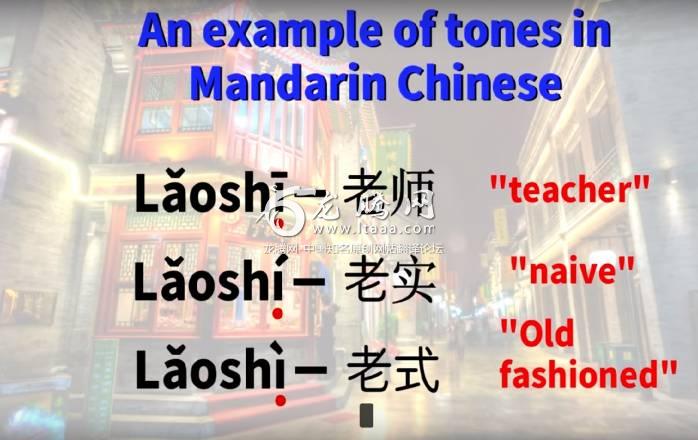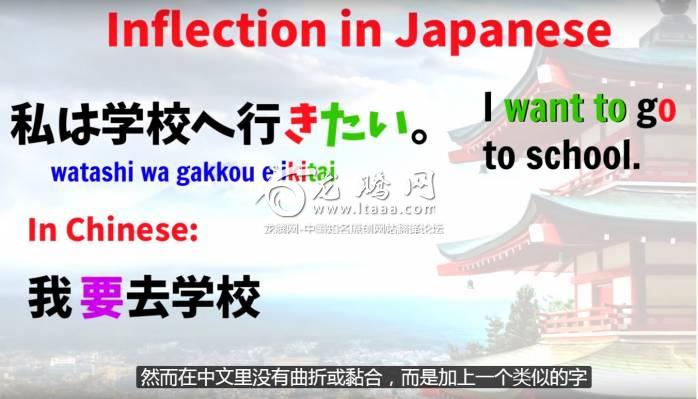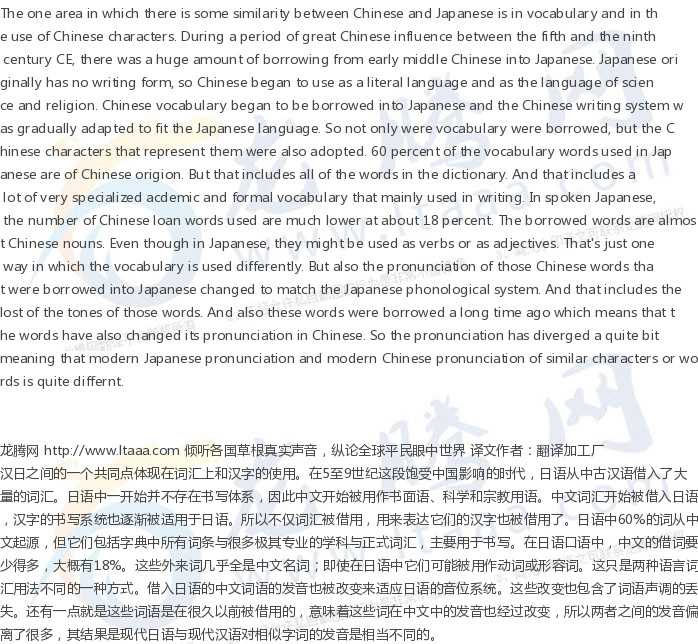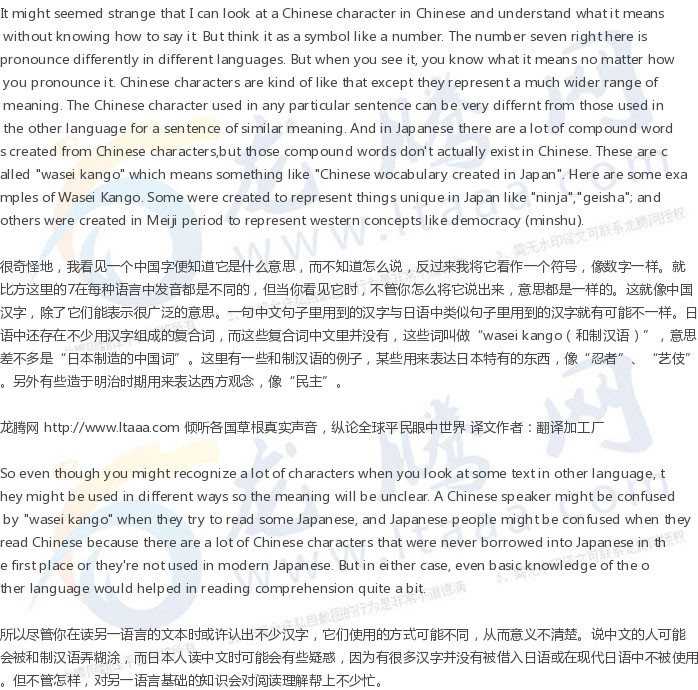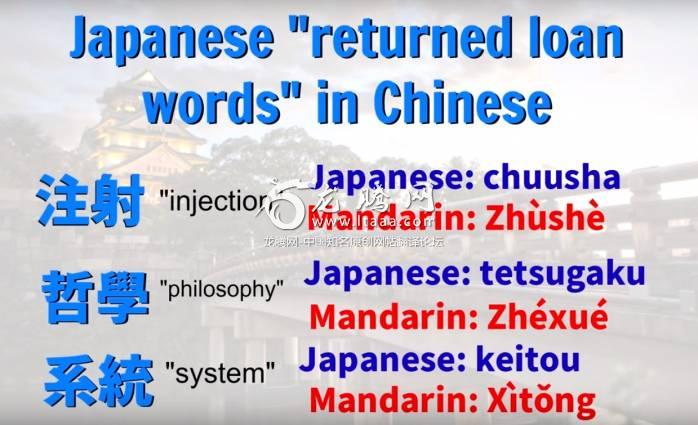汉语和日语有多相似? [美国媒体]
很多人看着亚洲地图会发现,中国与日本有多近,或者他们看着中文与日文的书写,觉得有些东西类似,然后他们就有可能推断两种语言很相似。但是这两种语言真的相似吗?简单地说,不对,它们是完全不同的两门语言......
每人一小段,翻译我也行!
每日新素材,等你来认领! http://www.ltaaa.com/translation.html
-------------译者:龙腾翻译总管-审核者:龙腾翻译总管------------
视频本身有字幕,所以专注英文评论翻译。感兴趣的链接在此:https://www.youtube.com/watch?v=aHC3i6N9Wvk
Quziz time! Are the following words Chinese or Japanese?
小测试:以下的词语是中文还是日语?

(答案是:日语、中文、皆是、皆不是)
Today's topic is: How similar are Chinese and Japanese?
今日主题:中文与日语有多相似?
A lot of people look at a map of Asia and see how close Japan and China are, or they might looked at a sample of Chinese and Japanese writing, and think something looks similar, and they might concluded that the two languages are similar. But are they really similar? Well, the short answer is no. They are completely different languages. But Japanese has been highly influenced by Chinese in Vocabulary and writing system. Chinese and Japanese don't share a common origion, and they don't belong to the same language family. The Chinese language belongs to the Sino-Tibetan language family and Japanese, as far as we know, belongs to the Japonic language family.
很多人看着亚洲地图会发现,中国与日本有多近,或者他们看着中文与日文的书写,觉得有些东西类似,然后他们就有可能推断两种语言很相似。但是这两种语言真的相似吗?简单地说,不对,它们是完全不同的两门语言。但是日语在其词汇与书写系统方面深深地受到了中文的影响。中文与日文没有任何共同起源,并且不在同样的语系。中文属于汉藏语系,而日语,就我们所知,属于日语系。
1) Fonology:
音系学
First of all, the fonology of the languages is very different. With the basic difference is been that Chinese is a tonal language while Japanese is not. A tonal language is one or which their tones are pitches that help determine the meaning of the words you use. If you use the wrong tone, then the meaning of the word changes. Here's an example for teacher:(见下图)So I'm sure that the Chinese teacher get called naive or old-fashioned all the time by mistake. Or maybe not by mistake?
首先,两种语言的音系学截然不同。其最基本的差异为汉语是声调语言,而日语不是。在声调语言中存在声调或音高来帮助确定词语的意思;如果你用了错误的声调,词句的意思改变。下面是一个例子:(见下图)。所以我确定汉语老师们总是被错误地叫成“老实”和“老式”。或者可能是故意的?
In Japanese there are basically no tones that determine the meaning of the words. In Japanese, there is something called "pitch accent" which means that the syllables of a word have either a higher pitch or a lower pitch. But they're not like the tones in Chinese, because they typically don't determine the meaning of the word. They're more like stress in English.
在日语里基本上没有这种声调来取决词句的意义。日语里有“重音”,意思是一个词语的音节或是发高音,或是发低音。但是它们不像中文里的声调,因为他们一般不被用来决定词语的意思。它们更像英语里的重读。
2)Structure:
结构
The structure and grammar of the two languages are completely different. And the most basic level, Chinese is a SVO language while Japanese is a SOV language. Here's an example in Chinese(见下图)This means he speaks Chinese. And as you can see S, V, O. And here's that sentence translated in Japanese. Here we can see S O V. And you can see some extra little words in Japanese that don't exist in the Chinese sentence. For example, Japanese has the topic marker "wa" which doesn'r exist in Chinese and Japanese also the object marker "wo" which doesn't exist in Chinese.
两种语言的结构与语法完全不同。从最简单的层面来看,中文是一门SVO(主谓宾)语言,而日语是SOV(主宾谓)语言。下面是汉语的一则例子:他说中文。SVO:主语、动词、宾语。下面是这句句子的日文翻译;这里你看到SOV:主语、宾语、动词。你可以看到日语中有有些多余的小词不存在于中文句子里。比如,日语里的一个话题标记“は(wa)”在中文中是不存在的。日语还有个宾语标记“を(wo)”在中文句中也不存在。
Chinese is an analytic language which basically means that you create a sentence by placing independent elements side by side. And analytic language like Chinese do not use inflection. Inflection means modifying words to indicate grammatical meaning like plural, gender, tense, case, etc.. You don't change any part of the word in order to change its meaning. Instead you can add to the meaning of the word by adding an extra word next to it. Japanese, on the other hand, is an agglutinative language that uses inflection. An agglutinative language uses a lot of affixes rather than just placing independent words side by side, you attach additional pieces to words to add or modify meaning. This kind of inflection in Japanese means that Japanese words are often longer than Chinese words. And that may take a few words in Chinese to translate one Japanese word.
汉语是分析语(孤立语),意思是你可以把独立的元素放在一起来组成一句句子。像汉语一样的分析语不发生曲折变化:曲折的意思是修改单词来表达一些语法含义比如复数、词性、时态或格。你不改变一个字的任一部分来改变它的含义。反之你可以在这个字旁边加上一个字来给它附加含义。日语反而言之是一门实用曲折变化的黏着语。黏着语使用很多的词缀,与将独立的字并排放置在一起不同,你附加几个字块来增加或修饰含义。日语的这种曲折性意味着日语单词比中文长,而翻译一个日语单词可能要用到几个汉字。
In these Chinese sentences, we can see there are no inflection. This sentence means I go to School. This sentence means I went to School. So no part of the verb is changed to indicate past tense. We can show the past tense by just adding a time expression. Now These similar sentences in Japanese show inflection. This sentence means I go to School. I went to school. And the polite form of "I go to school". I want to go to school.
在这些中文句子中没有曲折变化。动词没有改变以显示过去时态。我们加上一个时间短语来表示过去。这里类似的日语句子体现了曲折变化。(我去学校)、我去(了)学校还有“我去学校”的敬语形态。
In the Japanese example, we use inflection changing the word "iku" to the "iki" form and then we use an agglutination to attach a form that shows intention "tai". In Chinese though, there is no inflection or agglutination. You just add an extra word like this. That's just a brief sample of how different the grammar is in Japan and Chinese. Basically, they are completely different languages when it comes to the grammatical structure.
在这个例子里我们用了曲折变化把“行く(iku)”变成“行き(iki)”,然后黏合上表示意向的形式“たい(tai)”。然而在中文里没有曲折或黏合,而是加上一个额外的字。以上只是体现汉日语法区别的一个简单范例。总而言之它们在语法结构上是完全不同的语言。
3)Vocabulary and Chinese characters:
词汇与汉字
And it's also important to point out that mandarin was not the standard form of Chinese back in those days when those vocabulary words were borrowed into Japanese. So even at that time they were borrowed, the pronunciation was different from standard Chinese today. From what I understand, the modern Japanese pronunciation of those long words is often more similar to modern Cantonese than it is to mandarin. These examples show how the same words pronounced very differently in Japanese and mandarin. The word for family in Japanese is "katei". And actually in Japanese, the meaning is more like "household" or "home". And in mandarin (the pronunciation) is "jiating"....So you can see those words look the same and they have basically the same meaning, but they sound very different.
另一个需要强调的重点是,普通话在日语大量借词时并不是标准汉语。甚至当时的发音与现在的标准汉语有别。而且我认为现代日语中借词的发音通常与现代广东话更相近而不是普通话。这些例子告诉你日语与普通话中同一词语如何有不同的发音。比如家庭这个词,日语发音为“katei”日语里这个词语表达的意思其实更像是家人群体。中文发音为“家庭”。(之后例子略)你看这些词看起来一样,意思基本上一样,但听起来很不一样。
So Chinese vocabulary words represented by Chinese characters were borrowed into Japanese, but those Chinese characters were also then applied to native Japanese vocabulary that had related meanings to those Chinese loaned words. That means a Chinese speaker can often look at a native Japanese word and undertstand its core meaning without knowing that Japanese word,because the Chinese character is used to represent it. So Chinese people can often read a text in Japanese and they can make sense of the basic meaning of it based on the Chinese characters, but they won't understand all the details.
用中国汉字书写的中文词汇被借入日语,但那些汉字同样被使用于日语中,意思与中文借词有关的本土词汇。这代表着一个汉语使用者通常可以看着一个本土日语词并理解其主要意思,即使不认识这个日语词。因为一个汉字被用来代表它,所以中国人经常可以读懂一段日语中用中文汉字写出来词语的基本意思,但却不能理解所有的细节。
And the same is true in reverse, Japanese people can look at a Chinese text and kind of make sense of the meaning of it based on the Chinese character that they know. But it is easy to misunderstand the details of what was written,esepically they have zero knowledge of the other language. Here are some Japanese example sentences that have the same Chinese characters, but the meaning is very different because of the inflection that's used. The cat eats fish. The cat doesn't eat fish. The cat ate fish. In the past tense. The cat plans to eat fish. The cat was eaten by a fish.
反过来也一样:日本人可以看一段中文文本并凭借着他们所认识的汉字了解其基本意思。但是对细节的误解经常发生,特别是在对另一语言没有任何基础的情况下。在这些例子中用到的汉字在两种语言中意思一样,但在句子中的意义非常不同,因为这里使用了曲折变化(见下图)。猫吃鱼。猫不吃鱼。猫吃了鱼(过去式)。猫计划吃鱼。猫被鱼吃了。
So a Chinese speaker reading these sentences would get the core meaning of the Chinese characters, but they would miss some meaning in the inflection. For example, the negative or the past tense, or the intention or the passive form. Especially the last example could be highly misunderstood. So imagining you are a English speaker reading something with English loan words, it might look something like this: Cat bla fish bla food bla bla.
如果一个中国人读了这些句子,他会理解其中汉字的主要含义却会忽视曲折变化所表达的意思。比方说否定、过去式、意愿或被动语态。最后一个例子特别容易被误解。想象你自己作为一位英语使用者来读英语的借词,感觉会是这样:(见下图)猫…鱼…吃的…
Of course, even after just a little bit of studying in Japanese, the Chinese speaker could probably learn enough to understand basic Japanese sentences like that. For me, as someone who study Japanese to a relatively advanced level, the same is true in reverse. When I was in Taiwan last year, on the subway for example, I could read a lot of the advertisements and I would get most of the meaning, I wouldn't understand all of the Chinese characters, but I could usually get 3 out of 4 of them. And the fourth one would be new to me, because in Chinese there are a lot of characters that actually aren't used in Japanese at all. But just getting 3 out of 4 of them was often enough to understand the basic meaning of that advertisement. But of course I have no idea how to pronounce those Chinese characters. And if I try to read them out loud like Japanese, I would hear laughter both from my girlfriend and local bystanders.
当然通过一点点的日语学习,中国人也许就足够理解这样的基础日语句子。对像我这样学至高级日语的人来说,反过来也说得通:比如说我去年在台湾的地铁上就可以读懂很多的广告,并且可以看出大部分的意思。我不会理解所有的汉字,但通常可以猜出4个里面的3个字,而第4个字对我来讲很陌生,因为中文有很多日文里根本没有的汉字,但4个字里面看得懂3个通常足够让我看懂广告基本的含义。但是当然咯,我不知道怎么读出那些中国字,当我像日语中的那样读出来,我会被我女朋友和当地人笑话。
4)Japanese "returned loan words" in Chinese:
日语给中文还借词
So as we have discussed already, lots of Chinese vocabulary was borrowed into Japanese, but some Japanese vocabulary has also been borrowed into Chinese. A moment ago I mentioned "wasei kango", Japanese vocabulary created from Chinese roots, vocabulary that doesn't exist in Chinese. But some of those "wasei kango" have actually been borrowed from Japanese into Chinese. Some sources say that such vocabulary counts for around 30% of modern Chinese vocabulary. Of coures the way those "returned loan words" are pronounced based on the modern Chinese pronunciation of the Chinese characters. Here're some examples:(见下图)
我们前面已经提到过,很多中文词汇被借入日语,但是有些日语词汇也被借入中文。我前面提到了“和制汉语”——日语中用中文造的而中文里不存在的词。但有些和制汉语事实上被借入中文。一些资料称这些词汇组成大约30%的现代汉语词汇。当然这些“回归的借词”的发音取决于现代汉语中的发音。这里有些例子:历史、工业、电子、注射、哲学、系统等。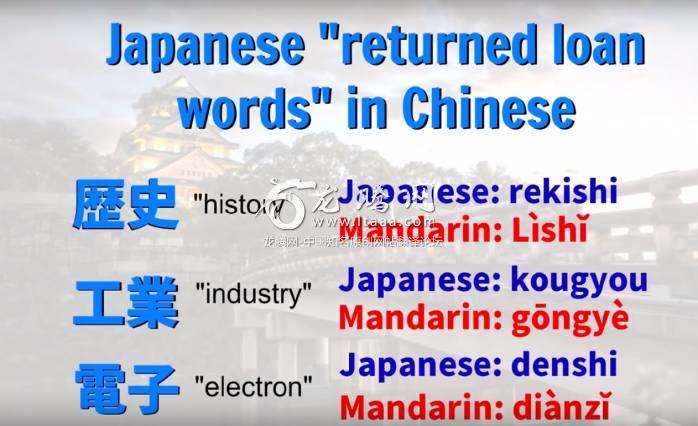
And most Chinese people these days are probably not even aware of those words were borrwed from Japanese. It's also to point out that in mainland China, simplified Chinese characters are now used as opposed to the traditional Chinese characters used in Taiwan and Hongkong. That means someone from mainland China may have more trouble recognizing Japanese kanji than someone from Taiwan for example. So in short, Chinese and Japanese are very different languages, especially the spoken languages. Even though there was a lot of vocabulary borrowed from Chinese into Japanese and a little bit from Japanese into Chinese. Only in writing are those two languages somewhat intelligible because of the Chinese characters that are used.
今天大部分的中国人有可能都不清楚这些词其实是从日语里借来的。还要注意的是,在中国大陆简体字代替繁体字使用,繁体字用于台湾与香港,意味着一位中国大陆人可能会比一位台湾人更难理解日语汉字。简而言之,中文与日文非常不同。特别是口语,尽管有很多词汇从中文借入日文和一些从日语借入中文,只有在书面语中,由于中国汉字的缘故,这两种语言才某种程度上互通。
-------------译者:言止于我-审核者:龙腾翻译总管------------
tiansun li
I'm Chinese I have no problem reading the text on the cover of Japanese porn.
我是中国人,而我读日本A片封面文字毫无压力。
LeiFengMedia
Chinese mainlanders do NOT have trouble reading traditional Chinese characters. Traditional Chinese is very easy for us to read and understand because only a few characters are actually changed in simplified chinese and are still heavily recognizable from their simplified form. Also many places still use and have Traditional characters like temples shops ect so Traditional characters are still all around us. We only have trouble with writing Traditional Chinese as we are not required to learn how to write these characters in their Traditional forms (and because some are so complex they're difficult to remember all the strokes) Also very sorry for my English.
中国大陆人是看得懂繁体字的。对我们来说,繁体字是很容易读懂的,因为只有少数汉字被真的简化了,但是这些汉字依然能很容易从其简化形式认出来。许多地方依然使用繁体字,比如寺庙,商店等地方,所以传统繁体字依然存在在我们身边。我们只是在写繁体字时有点困难,因为我们没有被要求学习怎么写这些字的繁体形式,(因为一些字的笔画非常复杂,太难记了)英语不好,抱歉哈。
mochimochi king
I'm a Japanese native speaker. Japanese people study how to read old Chinese sentence so we can understand modern Chinese to a certain extent.
我是日本母语者。日本人学习中国古文,所以我们一定程度上懂得现代中文。
Gak Vivien Roppongi
I'm a Japanese highschool student who is Japanese native speaker and speaks English and French. All Japanese students must learn old Chinese in both middle School and highschool and it's also one of the subjects on universities'enrollment tests (it's like SAT or ACT). Since we frequently interacted with China trading cultural connection religion or even many Japanese went off China to study in the very old time like 700~900 AD we learned many things: poems governance architecture and so on. So it's essential to learn "Japan". Americans learn British history and native American's history. It's the same thing since they are highly effected by those two cultures. So I think many Japanese can understand the outlined ideas of Chinese language we can never pronounce words though. Actually we sometimes understand the meanings of them because of the prononciation. Those who are intelligent and know simplified Chinese characters can read and grab its meaning. A funny thing is they may understand better old Chinese language than Mandarin or other modern Chinese languages.
我是一名日本高中生,母语为日语,同时还会说英语和法语。所有的日本学生在初高中都必须学习中国古文,同时这也是高考必考科目(像SAT和ACT)。由于我们与中国在贸易、文化和宗教信仰上有很频繁地交流与联系,在公元700-900年间甚至有大批日本人去中国留学,学到了许多东西:诗歌、治国、建筑等等。所以(学习古文)对学习(了解)“日本”非常重要。美国人学习不列颠历史和美国本土历史,他们深受这两种文化的影响,这和日本一样。所以我认为许多日本人能懂个大概,虽然我们不知道该怎么发音。实际上有时我们能从发音知道意思。那些知道简体字的聪明人一般都能读懂这些简体字在说什么。一个搞笑的事情是,他们的中国古文比普通话或者其他现代汉语都强。
-------------译者:屠妖-审核者:龙腾翻译总管------------
Jason Y
as a Chinese like you said I can read the sentence in your example just like cat bla fish bla eat bla bla
作为一个中国人,正如你所说,我在读你举例的句子时就是:猫...鱼...吃……
tao han
2 个月前
中:一把把把把住了(有没同志觉得把在这里出现太多,已经让人有点怀疑是错别字了......)
日:ハンドルを片手に住んでた
En:Straighten the steering wheel
英文版:扶直方向盘。
ka.N KAN
I'm Japanese.
Chenese language is not easy for me but I understand many I mean a few handreds of characters.
山(mountain) in Chinese means 山 in Japanese.
海(sea) means 海.
川(stream river) means 川.
我是日本人。中文对我而言并不简单。但我能看懂数百个汉字。
山:在中文的意思和日文是一致的;海:也是;川:也是。
MrPob Pob
The thai word in this video 0.27 mean "I'm in jail" lol
哈哈哈哈,视频0.27时的泰语说的是“我进局子了”。
パンあげ
Japanese has just 3type of lattersb34;
And each kanjis have many ways to call.
生→this kanji can read over 100 waysb34;
That's all🙂
日语只有3种声调;但每个日本汉字却有很多发音方法。比如“生”这个字,有100多种读法。我想说的就这些:)
Lorosa'e
I'm Japanese. When I look at Chinese text I feel I can understand almost all of the meaning. But it would be often totally wrong after getting it. This is because there're so many words that have the same kanji but completely different meaning between Chinese and Japanese. For instance "大丈夫" means "It's OK" in Japanese but "full-fledged man" in Chinese. Sorry for my poor English.
我就是日本人。我读中文课本的时候基本能理解所有文字的意思。但有时候文字所表达的意思与我的理解完全是相悖的。因为虽然日语和汉语有很多相同的汉字,却在日语和汉语中代表不同的意义。比如“大丈夫”在日语中表示“没关系”,但在中文里却是指“男子汉(成熟男人)”。我英语不好,抱歉。
Jenny Ni
Speaking of Japanese pronunciation it is very similar to Shanghainese (one of the Wu languages) more than Cantonese (as described in the video).
说到日语发音,它听上去更像是上海话(吴语之一)而不是广东话(如视频中所述)。
Gillian Fisher
I had about a year of Chinese before I started learning Japanese. To this day even though I still use both languages when I read Japanese [and come across a kanji] my brain initially associates it with the Chinese pronunciation. Instead of "English bla English bla English bla bla" it ends up being something like "Chinese Japanese Chinese Japanese Chinese Japanese Japanese." (I hope that makes sense.) Rarely do I ever have trouble speaking though since the languages are so different.
在我开始学习日语之前,我学了大概一年的中文。直至今日,尽管我两种语言都用,但当我读到日语(和里面的汉字)时,我的大脑还是会首先联想到中文里的发音。我大脑最终闪现的是“中文–日文–中文–日文–中文–日文”,而不是“英文blabla英文blabla"(希望你们看得懂我在说什么)。尽管这两种语言如此不同,但我在说话时很少遇到困难。
Camaro the Great
Let me show you how similar Chinese and Japanese are: 手纸(Japanese-Postcards Chinese-Toilet Paper) 切手(Japanese-Stamp Chinese-Cut Hand) 爱人(Japanese-Mistress Chinese-Wife) 勉强(Japanese-Study Chinese-unconvincing forced) 先生(Japanese-Teacher Chinese-Mr.) 娘(Japanese-daughter Chinese-Mother) 有难う(Japanese-arigatou Thank you Chinese-有难 means accident disaster catastrophe) 邪魔(Japanese-Bother disturb Chinese-evil demon) 文句(Japanese-complaint Chinese-sentence) 大丈夫(Japanese-It's okay Chinese-Strong man upright man) 丈夫(Japanese-robust Chinese-husband).汤(Japanese-hot water Chinese-Soup but in Chinese idiom 赴汤蹈火 they have the same meaning as hot water)
让我给你看看中文和日文有多相似:
手纸(日:明信片;中:厕纸);切手(日:邮票;中:割手);爱人(日:情人;中:老婆);
勉强(日:学习;中:无法令人信服、被迫);先生(日:老师;中:x先生);
娘(日:女儿;中:母亲);有难う(日:谢谢; 中:意外,灾难);
邪魔(日:困扰,打扰;中:邪恶、魔鬼);文句(日:抱怨;中:句子);
大丈夫(日:没关系;中:强壮的男人、正直的男人)丈夫(日:强健壮实;中:老公);
汤(日:热水;中:汤),虽然在 成语“赴汤蹈火”中汤指的是热水。
-------------译者:龙腾翻译总管-审核者:龙腾翻译总管------------
ZaiPenser
The meaning of 老实 is actually closer to "honest" than to "naive".
“老实”的意思更接近“诚实”而不是“天真”。
Larry F
Sounds like the role of Chinese words in Japanese is very much like French words in English. In a way also the writing since so many French words are recognizable to an English speaker in print but are pronounced very differently e.g. point centre
听起来汉字在日语里的作用很像法语单词在英文里的作用。某种程度上在书写上也是如此,因为讲英文的人能认出很多法语单词,但两者却读音大不相同,比如point、centre等。
いじょう
Any mistake request for comment.
我要说的就以上这些,有任何错误,欢迎评论指正。
Lethal Discharge
I was watching this being very informed and not expecting to laugh then the bla bla part happened and I died.
我在看这个视频时是准备好了学习知识,没期待会被逗笑,然后出现了blabla那部分,我笑死了。
Haobin Song
he did that right) that's exactly how we Chinese feel when we read Japanese..
他总结得很对,这就是我们中国人读日语时的感受.....
-------------译者:ViperGTS-审核者:龙腾翻译总管------------
Reading text in just Kana is quite frustrating since many Japanese words have multiple meanings despite being written the same way.
Kanji solves this problem for the most of the time.
如果是阅读只有假名的文章就会发现十分费解,因为很多日语词即使写法相同,却有很多种意思。日本汉字很多时候就能解决这个问题。
kaisermuto
Japanese grammar and Chinese grammar are different each other. And Japanese Kanji pronunciation has many way while Chinese kanji has only one pronunciation.
For example 生has ikiru sei sho nama jou ki o umareru pronunciations. While chinese has only "Shen".
日语和中文的语法也各不相同。而且日语汉字的发音可能有很多种,但中文汉字只有一种发音。比如“生”这个字,日语可以发音作“ikiru、sei、sho、nama、jou、ki、o、umareru ”等,但中文只发“shen”这个音。
(审核注:这位仁兄不知道中文有多音字这个存在吧)
Simon Wilson
生 is sheng instead of shen
(吐槽楼上)“生”发音为“sheng”,不是“shen”。
sing w
You still have to learn more chinese grammar
中文语法你学得还差很多呢。
Suki L.P
As a Chinese teacher I could tell you it is not 100% correct. We use "了“ to indicate something happen in the past. I went to school is 我去学校了 / 我去了学校。 Where to place the "了” could be very tricky. It is depends on what the second part of the sentence might be. Putting the "了“ before school (the subject) normally dedicates you want to explain what has happened after you went to school. If your sentence ends at I went to school you normally put the “了” right after the subject “school” . However you could also use ”了“ with future tense sentences such as things are about to happen. Such as It is about to rain I am about to arrive and etc. My students found it very hard to master ”了“ and I totally agree with them.
作为一名中文教师,我能负责的告诉你,你视频中的说法并不是百分之百的正确。我们在中文里使用“了”这个字来表示发生在过去的事件。比如“I went to school”,中文译为“我去了学校”或者“我去学校了”,这个“了”字的用法其实十分严格,完全取决于句子第二部分是什么。将“了”放在学校(主语)这个词之前,通常是想表达去了学校之后发生了什么。如果你句子在写到“I went to school”就完了,你通常会把“了”这个字放在主语“学校”这个词右边。然而在某些将来时态的句子中,你也可用“了”来表达即将发生之事。比如“马上要下雨了”,“我马上就到了”等等。我的学生发现“了”字的用法很难掌握,这我完全认同。
版权声明
我们致力于传递世界各地老百姓最真实、最直接、最详尽的对中国的看法
【版权与免责声明】如发现内容存在版权问题,烦请提供相关信息发邮件,
我们将及时沟通与处理。本站内容除非来源注明五毛网,否则均为网友转载,涉及言论、版权与本站无关。
本文仅代表作者观点,不代表本站立场。
本文来自网络,如有侵权及时联系本网站。
图文文章RECOMMEND
热门文章HOT NEWS
-
1
Why do most people who have a positive view of China have been to ...
- 2
- 3
- 4
- 5
- 6
- 7
- 8
- 9
- 10
推荐文章HOT NEWS
-
1
Why do most people who have a positive view of China have been to ...
- 2
- 3
- 4
- 5
- 6
- 7
- 8
- 9
- 10


